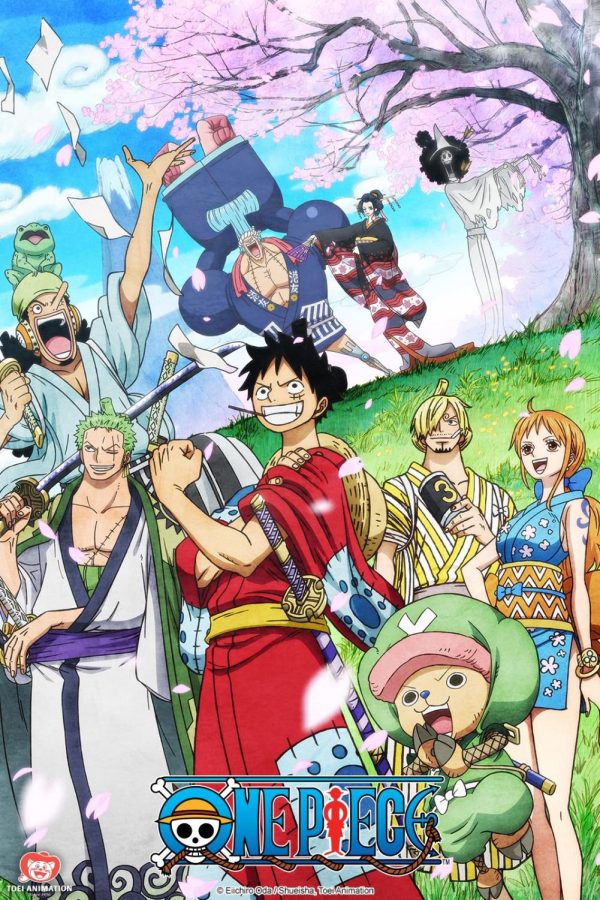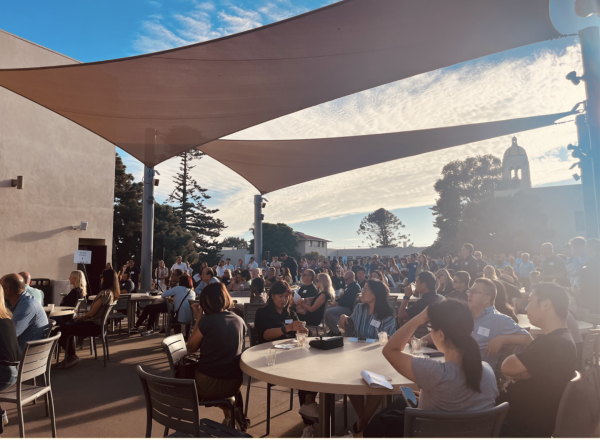One Piece of American Culture
What has caused anime to have such an enduring popularity?
One Piece and many other anime titles have sustained their popularity from the pandemic in recent years.
As I grabbed another fistful of movie theater popcorn, an intriguing trailer caught my eye. Six years from its initial release, the English version of the anime One Piece: Gold reappeared in select theaters for its anniversary. The re-release was a tribute and yet also evidence of Japanese animation becoming more mainstream.
Anime like Demon Slayer, which follows the adventures of teenager Tanjiro Kamado, exploded in popularity. Demon Slayer: Mugen Train currently sits at the 25th spot on the highest grossing movies of 2021. Raking in 21 million dollars in the United States on its opening weekend, it earned a total of 504 million dollars worldwide. According to Parrot Analytics, the global demand for anime increased 118% since 2020. These statistics suggest the enormous pandemic-driven increase in the anime fanbase worldwide.
Tracing the trend to its origins, lockdowns motivated people to find hobbies and interests within their own homes. As a result, media binging marathons became commonplace. Fans frequented their favorite streaming platforms such as Netflix, Hulu, or Crunchyroll, which caters specifically to anime.
For example, anime watcher Gabby Gaspar (‘25) got into anime because of her brother. However, “over the pandemic I guess I was just bored all the time so I would binge watch,” she said. Gabby wasn’t the only fan binging anime during that time. As of 2022, Crunchyroll currently has 120 million users, a significant growth from when the media site had barely 2.6 million users in 2019.
Co-President of the Japanese Art and Culture Club Ariston Oakes (‘23) started watching anime when he was around five or six years old. Ariston theorized that the rise in popularity resulted from people not going out as much. He said that the “accessibility” of anime was the reason for its popularity. He’s not wrong: according to the data of The Association of Japanese Animations, in 2020, the anime industry experienced a 3.2% growth. The industry earned 1,239.4 billion dollars overseas, a large difference from the 9.7% decrease in Japan’s anime industry. According to AnimeNewsNetwork, with this growth “the overseas market size surpassed the domestic market for the very first time.”
Fast forwarding to 2022, the Ronin Anime Expo occurred in Los Angeles on August 13. Anime fans gathered together to collect merchandise and cosplay their favorite anime characters. Booth volunteer for Anime Los Angeles Kesha Nash-Johnson spoke from her own experience working in the anime community. “Anime is now marketed more towards kids and teens than it was for adults because the adults that grew up watching it are now also helping make [their own shows],” she said. She continued by saying that streaming platforms played a part in allowing “a lot more people to have access to anime that they would usually have to move over to a different avenue to consume.”
An anime streetwear vendor since 2012, Lupita Lopez noted that she saw an increase in her sales since the pandemic. As a member of the anime community since 2009, she noticed that “more people than [she] would expect” have started attending the anime conventions where she vends. Lupita noted that people are now being more open to expressing their interest in anime.
But it wasn’t always that way. Although anime is currently considered mainstream overseas, anime fan Henry Armstrong (‘25) noticed a stereotype around anime fans had existed. “There was a stigma around it where only really weird people watched it for interesting reasons,” Henry noted.
Ariston noticed a shift in this perception once the pandemic hit. “I think the stigma of watching anime kind of disappeared due to the large increase of people who watched it over the quarantine as well as the fact that it’s grown to be pretty influential in other forms of pop culture like music or film making,” Ariston said.
Beyond the lockdown-driven popularity, many other factors came together to build anime’s popularity as well. Through social media, anime has become a pop culture trend. Tiktok trends, such as the silhouette trend, utilized certain aspects of anime. With the silhouette trend, people used a red filter and posed with the shadow of their favorite anime characters.
Evidently, Japanese animation references have been more publicized in pop culture also. Celebrities like Kanye West and Billie Eilish are some of the many public figures who have shown their love for the genre. In his music video for “Stronger,” Kanye made several references to Akira, a manga and anime that is set in a dystopian Neo-Tokyo. On Twitter, he said that Akira was “the greatest animation achievement in history.” Billie Eilish often wears clothes with anime references, recently fashioning a Jojo’s Bizarre Adventure shirt.
Anime may have been able to make such a large impression due to its ability to appeal to many demographics. The genre has a diverse array of sub-genres including: horror, slice-of-life, romance, and fantasy.
Still, other aspects of anime may also contribute to the growing popularity of the genre. Some viewers enjoy the story aspect of anime. Henry started watching anime when he was 10. “Devilman Crybaby is probably my favorite anime of all time because of its complex ideas of human nature and sticking to your morality even in absolute chaos,” he said. Ariston added to Henry’s point, stating that he enjoyed Jojo’s Bizarre Adventure because it “has a pretty solid and cohesive storyline.”
Other viewers enjoy the art aspect of anime. Jasmine “Jazzy” Joseph (‘23) enjoys how animation can make the impossible come to life. “I also love anime because of the gorgeous art; I really appreciate how each anime has its own look and style,” she said. Jazzy enjoys the show Demon Slayer because of its “vivid and mysterious colors and creative character designs.”
Jazzy isn’t the only one who expresses her appreciation for the genre in other ways; a whole community around anime exists. Besides watching anime, some fans enjoy cosplaying, creating fan art, or reading manga (Japanese comics). Donning a black overcoat, combat boots, and a sleek purple wig, Jazzy cosplayed as Touka from Tokyo Ghoul for the 2022 Anime Expo in Los Angeles, California on Jul
y 1-4. Jazzy described cosplaying as “empowering” because she becomes another character. “It involves fun creativity and crafting to make parts of the costumes, and it’s super rewarding when it all comes together in the end,” she said.
Ariston recently started reading manga after watching his favorite anime. “My brother and I like to do costumes for Comic-Con, some of which have been based on anime characters in recent years,” he said.
Because of its widespread popularity, anime is now releasing more frequently on Netflix. Live-action adaptations have also been granted more funding. For example, longtime fan-favorites Cowboy Bebop and Kakeguri both have live-action adaptations on Netflix. At AnimeJapan 2022, Netflix revealed that they would be releasing 40 anime titles. And that number will only keep growing. In a licensing deal with Nippon TV, a Japanese television broadcasting company, Netflix picked up 13 titles. The long-awaited One Piece live-action is currently in production and has a budget of 200 million dollars to bring the adaptation to life. With these large amounts of financial backing and support, the popularity and culture of anime will only continue to grow worldwide.

Summer is a senior and Editor-in-Chief of The Tower. This is her fourth year on the staff and third on the editorial team, previously serving as a story...









